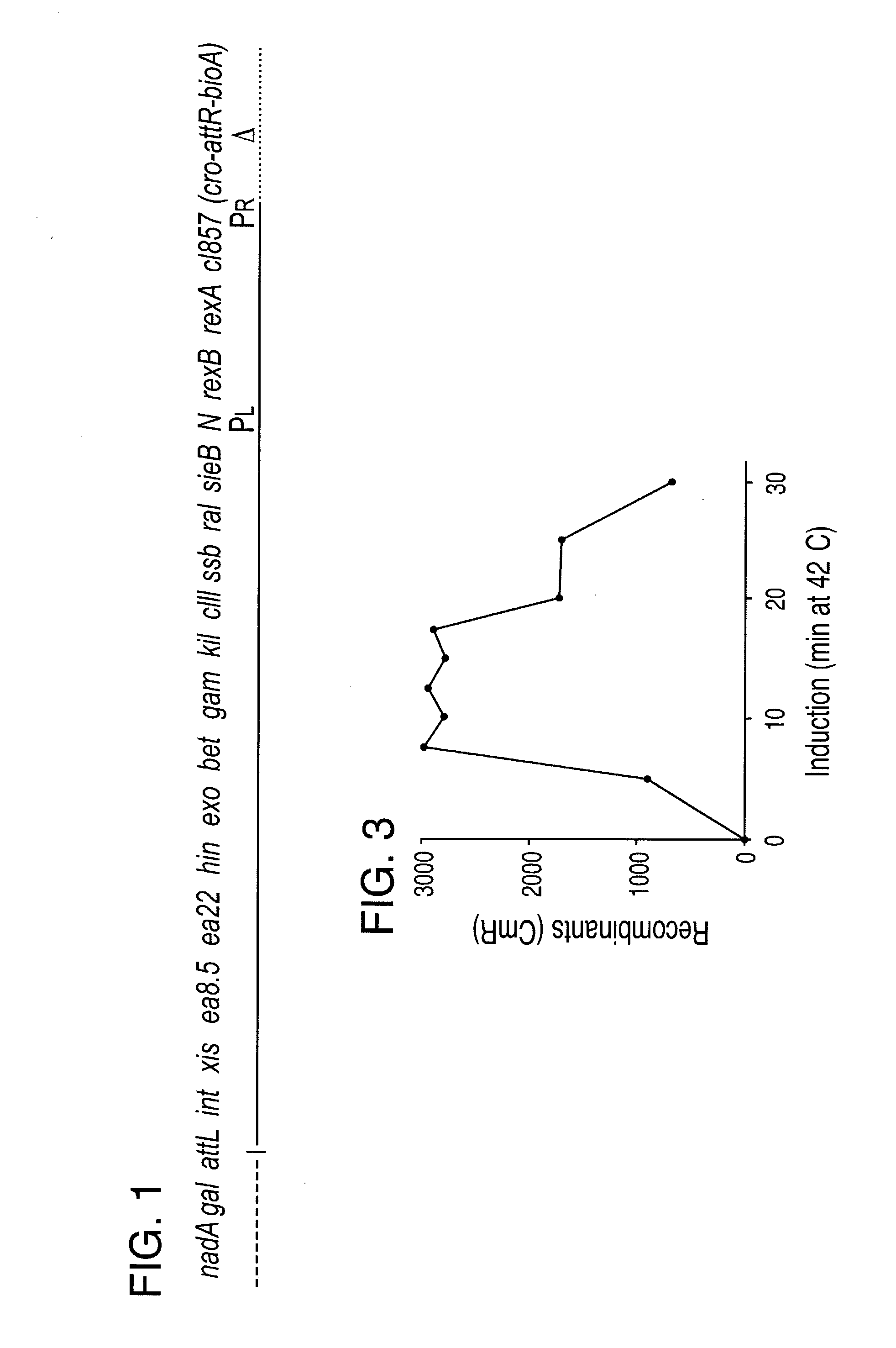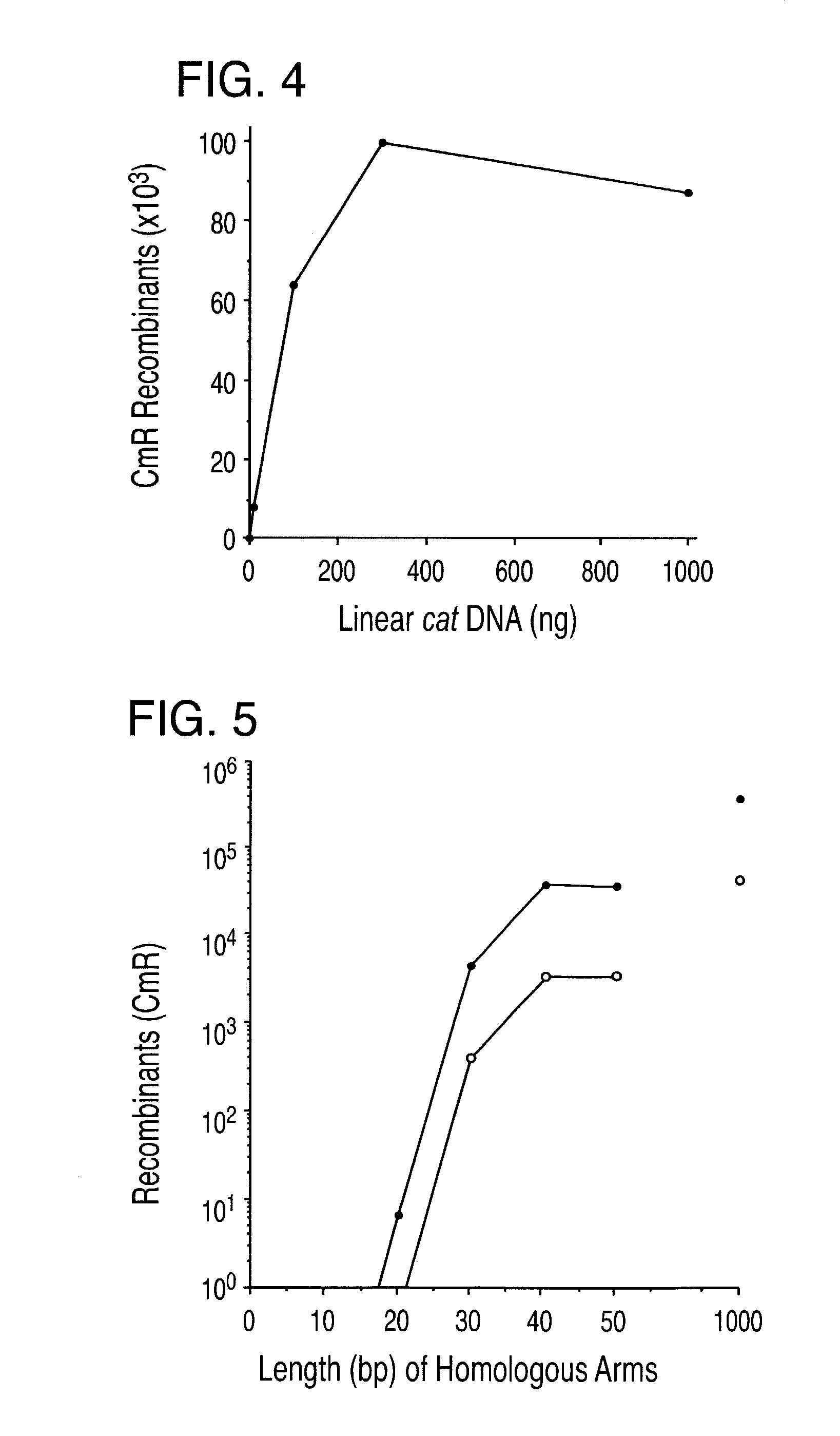Enhanced homologous recombination mediated by lambda recombination proteins
a technology of recombination protein and homologous recombination, which is applied in the field of enhanced homologous recombination mediated by lambda recombination proteins, can solve the problems of limiting the size of dna fragments that can be manipulated, and the restriction-ligation approach, and achieves less than 25 kilobases
- Summary
- Abstract
- Description
- Claims
- Application Information
AI Technical Summary
Benefits of technology
Problems solved by technology
Method used
Image
Examples
example 1
[0190] Modified Lambda Prophage for Defined Expression of Recombination Proteins
[0191] The molecular genetics of lambda bacteriophage, including its lytic and lysogenic growth cycles, is described in Sambrook et al., Bacteriophage Lambda Vectors, Chapter 2 in Molecular Cloning: a Laboratory Manual, 2nd Ed., (c) 1989 (hereinafter Sambrook et al., Ch. 2); Stryer, Control of Gene Expression in Procaryotes, Chapter 32 in Biochemistry 3rd Ed., pp. 799-823, (c) 1988 (hereinafter Stryer); and Court and Oppenheim, pp. 251-277 in Hendrix et al. eds., Lambda II, Cold Spring Harbor Lab Press, (c) 1983 (hereinafter Court and Oppenheim). The complete sequence of lambda is known (see GenBank Accession No. NC 001416, herein incorporated by reference).
[0192] Phage lambda has a well-characterized homologous recombination system. Double strand breaks in DNA are the initiation sites for this recombination (Thaler et al., J. Mol. Biol. 195:75-87, 1987). Lambda exonuclease (Exo) degrades processively fr...
example 2
[0200] Bacterial Strains, Expression of pL Operon, Electroporation Methods, Identification of Recombinants
[0201] Bacterial strains used in this work are listed in Table 2.
2TABLE 2 Strains Genotype WJW23 his ilv rpsl .DELTA.(argF-lac)U169 nadA::Tn10 gal490 .lambda.cI857 .DELTA.(cro-bioA) ZH1141 W3110 .DELTA.(argF-lac)U169 gal490 .lambda.N:lacZ .DELTA.(N-int) cI857 .DELTA.(cro-bioA) BR3677 lacl.sup.q lacZ (M15) .DELTA.(srl-recA)301::Tn10 DY329 W3110 .DELTA.(argF-lac)U169 nadA::Tn10 gal490 .lambda.cI857 .DELTA.(cro-bioA) DY330 W3110 .DELTA.(argF-lac)U169 gal490 .lambda.cI857 .DELTA.(cro-bioA) DY331 W3110 .DELTA.(argF-lac)U169 .DELTA.srl-recA)301::Tn10 gal490 .lambda.cI857 .DELTA.(cro-bioA) DY378 W3110 .lambda.cI857 .DELTA.(cro-bioA) W3110 "Wild-type" HME5 .DELTA.(argF-lac)U169 .lambda.cI857 .DELTA.(cro-bioA) HME6 .DELTA.(argF-lac)U169 galK.sub.tyr145UAG.lambda.cI857 .DELTA.(cro-bioA) HME9 .DELTA.(argF-lac)U169 galK.sub.tyr145UAG.lambda.cI857 .DELTA.(cro-bioA) tyrTVcat HME10 .DELTA.(arg...
example 3
[0206] Homologous recombination with short linear DNA fragments
[0207] The recombination system described in Examples 1 and 2 were used to generate a single bp mutation in the bacterial galK gene.
[0208] The galK gene encodes a galactokinase that phosphorylates galactose and its derivatives. The galK galactokinase phosphorylates 2-deoxygalactose to generate 2-deoxygalactose phosphate (2DGP). While unphosphorylated 2-deoxygalactose has no impact on cell growth, 2DGP is a nonmetabolized sugar phosphate that inhibits cell growth. Thus, cells containing a wild type galK gene grow poorly on 2-deoxygalactose, a phenotype referred to herein as Gal+. In contrast, mutants defective in galK grow well in the presence of 2-deoxygalactose (Dog), and have a phenotype referred to herein as DogR--(Adhya, pages 1503-1512 in Escherechia coli and Salmonella typhimurium: Cellular and Molecular Biology, Neihardt et al. eds., American Society of Microbiology, 1987). The DogR-phenotype enables ready selecti...
PUM
| Property | Measurement | Unit |
|---|---|---|
| temperature | aaaaa | aaaaa |
| temperature | aaaaa | aaaaa |
| volume | aaaaa | aaaaa |
Abstract
Description
Claims
Application Information
 Login to View More
Login to View More - R&D
- Intellectual Property
- Life Sciences
- Materials
- Tech Scout
- Unparalleled Data Quality
- Higher Quality Content
- 60% Fewer Hallucinations
Browse by: Latest US Patents, China's latest patents, Technical Efficacy Thesaurus, Application Domain, Technology Topic, Popular Technical Reports.
© 2025 PatSnap. All rights reserved.Legal|Privacy policy|Modern Slavery Act Transparency Statement|Sitemap|About US| Contact US: help@patsnap.com



